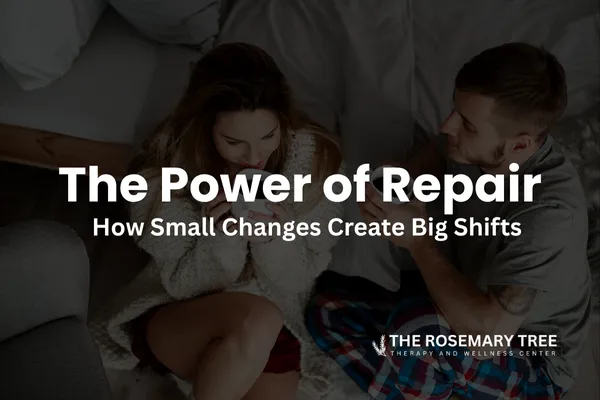
The Power of Repair: How Small Changes Create Big Shifts
Healing Happens in the Small Moments
When couples begin recovery after betrayal, many expect change to come through major breakthroughs or dramatic apologies. But in truth, most healing happens quietly, in the small, consistent moments of repair that teach your nervous system, “We’re safe again.”
A kind word after a hard conversation.
An honest check-in instead of silent withdrawal.
A willingness to listen instead of defend.
These may seem small, but they are the foundation of real transformation.
As we explored in When One Partner Does All the Work, progress is not about perfection or equality in every step. It is about mutual willingness to repair what has been broken, again and again, until safety feels steady.
What “Repair” Really Means
Repair is not just about saying “I’m sorry.” It is about noticing when disconnection happens and choosing to reconnect, calmly, respectfully, and with care.
In healthy relationships, small ruptures are normal. Everyone misunderstands, withdraws, or gets defensive sometimes. What matters is how quickly and thoughtfully the repair happens afterward.
When couples learn to repair effectively, they show each other that conflict is survivable, and love can remain even when things feel messy.
WhySmall Repairs Matter More Than Big Gestures
Grand gestures can feel comforting in the moment, but lasting safety grows from consistency. When your partner keeps showing up, even imperfectly, it teaches your body to relax and trust again.
The betrayed partner begins to feel safe expressing pain. The partner who caused harm starts to believe they can rebuild trust through action instead of guilt.
Each small repair rewires the nervous system for connection instead of fear. Over time, those moments accumulate into deep healing.
Examples of Everyday Repair
Taking a moment to ask, “Can we start over?” after a misunderstanding
Saying, “I see that hurt you” instead of explaining it away
Choosing to stay in the conversation when you want to walk away
Checking in before bedtime even when the day felt tense
Offering reassurance instead of silence
These simple moments are like emotional glue. They strengthen the bond piece by piece.
The Science Behind Repair
In attachment theory, repair is the process that rebuilds trust after rupture. Every successful repair releases oxytocin, the bonding hormone that helps calm the stress response.
This means every time you and your partner make a small repair, no matter how minor, you are literally reprogramming your brain and body to associate each other with safety again.
When we skip repair or avoid reconnection, cortisol levels stay high, keeping both partners in a cycle of vigilance or shutdown. This is why even a two-minute repair can change the emotional climate between you.
How Repair Connects to Accountability and Intimacy
As we saw in Taking Ownership Without Shame and Rebuilding Desire — When Love and Fear Coexist, repair is the bridge between accountability and closeness.
When a partner takes responsibility and then follows it with repair, it signals emotional maturity and care. The betrayed partner begins to trust not because the past is erased, but because the present feels safer.
Repair is what turns apology into action and tension into tenderness.
How Accelerated Outcomes Therapy Strengthens Repair
In weekly therapy, couples often run out of time right before the repair happens. Emotions rise, breakthroughs start, and the session ends.
Our Accelerated Outcomes Therapy Intensives give couples the uninterrupted time they need to move through rupture, repair, and reconnection, all in one structured experience.
During these intensives, couples can:
Learn repair techniques tailored to their relationship style
Practice emotional regulation during conflict
Experience guided repair conversations that rebuild trust
Develop a personal framework for daily repair at home
This focused, hands-on work allows couples to feel what real-time healing looks like, not just talk about it.
When Repair Feels Hard
If repairing feels impossible right now, it doesn’t mean your relationship is broken. It means you need safety before vulnerability.
Start with small steps. You do not have to resolve everything overnight. Simply choosing to stay open, to soften your tone, or to try again later counts as repair. Over time, these small efforts create big shifts in connection and trust.
Final Thoughts
Repair is not about being perfect. It is about being present. Every small choice to listen, soften, or reach out tells your partner, “We are still in this together.”
Healing after betrayal does not require flawless communication. It requires courage, patience, and consistency.
If you and your partner are ready to experience what real repair looks like, we would be honored to help. You can reach out to us here, and our team will connect with you to talk about what this process could look like. There is no pressure, only care, hope, and a space to rebuild what truly lasts.
